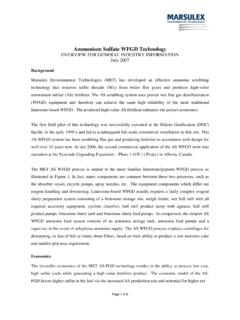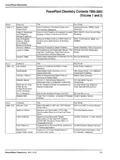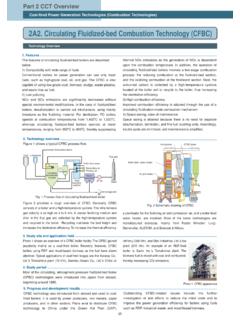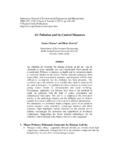Transcription of BENCHMARKING SO 3 REMOVAL – THE …
1 MET CleanStack Technical Paper Page: 1 BENCHMARKING SO3 REMOVAL THE CLEANSTACK PROCESS Ms. Amy P Evans* Director of Technology, Marsulex Environmental Technologies Inc. LLC, 200 North Seventh Street, Lebanon, PA 17046 Mr. Joseph A. Gresh Senior Project Manager, Marsulex Environmental Technologies Inc. LLC, 200 North Seventh Street, Lebanon, PA 17046 Mr. William Birmingham Director, Research & Development, ALSTOM Power Inc., Air Preheater Company, 3020 Truax Road, PO Box 372, Wellsville, NY 14895-0372 Dr. Steven A. Benson Senior Research Manager, University of North Dakota Energy & Environmental Research Center, 15 North 23rd Street, Stop 9018, Grand Forks, ND 58202-9018 Dr. Donald P. McCollor Technical Manager, University of North Dakota Energy & Environmental Research Center, 15 North 23rd Street, Stop 9018, Grand Forks, ND 58202-9018 ABSTRACT This paper presents the results of a full-scale demonstration of a proprietary technology for the reduction of sulfur trioxide (SO3) emissions from coal-fired power plant flue gases.
2 The technology, trademarked CleanStack , was developed jointly by Marsulex Environmental Technologies, the Energy & Environmental Research Center, and ALSTOM Power, Inc., Air Preheater Company. Dominion Energy hosted the demonstration of the technology at its Chesterfield Unit 5, utilizing one of the 350-MWe unit s two air preheaters for the project. Higher SO3 emissions, which result from the retrofit of selective catalytic reduction (SCR) technology to control NOx emissions, are considered significant corrosion and opacity concerns for high-sulfur coal-fired boilers. The additional quantities of SO3 generated by the oxidation catalysis of SCR elements on SO2 have led to serious plume conditions from chimneys and higher rates of downstream corrosion. The CleanStack technology utilizes the injection of ultrafine alkaline particles upstream of the boiler s air preheater to aid in the condensation and subsequent neutralization of SO3.
3 Collected SO3 is absorbed by the alkaline particles and MET CleanStack Technical Paper Page: 2 disposed of with the fly ash constituents. Advanced-design air preheater heating elements that resist fouling and enable more effective cleaning, ensure the reliable operation of the air preheater under CleanStack operation. In addition to solving a growing emission problem, the CleanStack technology may enable certain plants to increase their boiler thermal efficiencies by as much as 1% due to the increased heat transfer taking place across the air preheater. This benefit also translates into lower corrosion rates of downstream ductwork and electrostatic precipitator components, as well as enabling owners to more seriously evaluate fabric filters for high-sulfur applications. Fabric filters may enhance the company s ability to comply with future fine particulate and mercury regulations.
4 The paper presents the results of the full-scale demonstration program, including SO3 reduction performance, air preheater operation, and the discussion of several collateral benefits such as those cited above. INTRODUCTION Emission reduction strategies implemented by electric utilities on coal-fired plants include installation of flue gas desulfurization (FGD) systems for SO2 control and SCR technology for NOx control to meet the specific reductions in SO2 and NOx emissions required by the 1990 Clean Air Act Amendments. These technologies result in the potential for emission of SO3 and sulfuric acid aerosols that can result in increased stack opacity. The installation of FGD systems also allows the firing of high-sulfur fuels, which generate more SO3 than do more expensive low-sulfur coals. While effective for SO2 capture, wet FGD systems have been shown to have a minimal effect on REMOVAL of SO3.
5 The use of SCR for NOx control also may result in increased SO3 concentrations in the flue gas as a result of catalytic oxidation of SO2 by the SCR. This problem may be aggravated by ultrafine particles formed by the reaction of SO3 with excess ammonia present from the SCR process, resulting in a highly visible blue plume emitted from the stack. In the coal combustion process, SO3 comprises approximately of total sulfur emissions. Chemical equilibrium modeling shows essentially all the SO3 is converted to gaseous H2SO4 at a flue gas temperature of 400 F (204 C). Below the sulfuric acid dew point temperature (260 300 F, 127 149 C) when a sufficiently high SO3 concentration and a low ash particle loading is present in the flue gas, homogeneous condensation can occur, producing a submicron acid fume which is very difficult to collect in a dry electrostatic precipitator (ESP) or wet scrubber.
6 Emission of SO3 and acid fume may result in increased opacity and a conspicuous blue stack MET CleanStack Technical Paper Page: 3 The condensed sulfuric acid also has the potential to result in fouling and corrosion on surfaces in the air preheater, ductwork, and stack. Conventional wisdom dictates that flue gas exiting a regenerative air preheater should not fall below minimum temperatures dictated by the percentage of sulfur in the coal to avoid fouling and corrosion. However, local metal temperatures are always lower than the flue gas temperature, and the metal surface temperature at the cold end of an air preheater is typically below the acid dew point. Thus acid condensation is normally occurring at the cold end of an air preheater under typical operating conditions. Deliberate control of metal temperature gradients within the air preheater offers a potential method for enhanced SO3 and acid Dominion Generation has committed to upgrades to significantly reduce particulate and sulfur emissions at its Chesterfield facility.
7 A wet FGD and fabric filter baghouse are to be in service on Unit 6 by June 2008. The wet FGD will make possible the burning of higher-sulfur coals. However, this entails the need to reduce SO3 concentrations to less than a dew point temperature of 270 F to avoid back-end corrosion, damage to fabric filters, and visible stack emissions. The operating criteria for the SO3 control technology imposed the requirements of having no negative effect on unit operations, such as increased air preheater pressure drop or accumulation of material in the ductwork, high levels of reliability, operability and maintainability, low operating cost, and a reasonable capital cost. CleanStack meets these requirements. As a result, Dominion Generation entered into a full-scale plant demonstration of this technology. Other SO3 abatement technologies considered were the use of fireside reagents, reagent-based post-combustion additives, and wet ESP technology; however, they did not appear to meet all of the desired performance and operating requirements.
8 The basis of the SO3 reduction technology demonstrated at Chesterfield Unit 5 is to provide controlled condensation of SO3 by injection of ultrafine particulate material immediately upstream of the air preheater. The particle concentration provides nucleation sites for heterogeneous condensation in preference to both homogeneous condensation and condensation on metal air preheater surfaces. The condensation process does not depend on the composition of the particles, but only on the particle-size distribution and particle concentration. For the testing, limestone was chosen so as to provide a degree of acid neutralization after condensation has occurred. The Energy & Environmental Research Center (EERC), along with Marsulex Environmental Technology and the ALSTOM Power Inc.
9 , Air Preheater Company, has been working to develop solutions to SO3 emission problems in boilers. The goal of the Chesterfield testing was to demonstrate the effectiveness of the CleanStack SO3 control technology for removing SO3 from flue gas as a function of limestone feed rate and flue gas SO3 concentration. MET CleanStack Technical Paper Page: 4 EXPERIMENTAL Field Testing The site selected for the demonstration was Dominion Generation s Chesterfield Station. The Chesterfield Station consists of four tangentially fired units with a total electrical capacity of 1298 MW. The testing was performed on Unit 5 which is a nominal 350-MW unit firing 183,000 lb/hr of a bituminous coal The unit is a split-backpass design with SCRs for NOx control and cold-side ESPs for particulate REMOVAL . Dominion had previously upgraded the air preheaters on Unit 5 to include the advanced-design heating elements which would minimize the fouling concerns with CleanStack.
10 Specific objectives were to determine the baseline SO3 concentration at the air preheater inlet (SCR outlet), air preheater outlet, and ESP inlet; determine the particle-size distribution and feed rate of the limestone injection system using multicyclones; and determine SO3 REMOVAL efficiency across the air heater and at the inlet to the ESP at different limestone injection rates. This testing was preformed during the summer of 2006. A commercial SO3 generator that the plant uses for ESP conditioning was used to catalytically generate an elevated SO3 concentration that is anticipated to result from firing a higher-sulfur coal (~35 ppm SO3) with an SCR installed. The SO3 was injected into the flue gas at a location far enough upstream of the air heater to ensure uniform dispersion of the SO3. The control technology uses finely ground limestone injected immediately ahead of the air preheater as the SO3 REMOVAL media.








